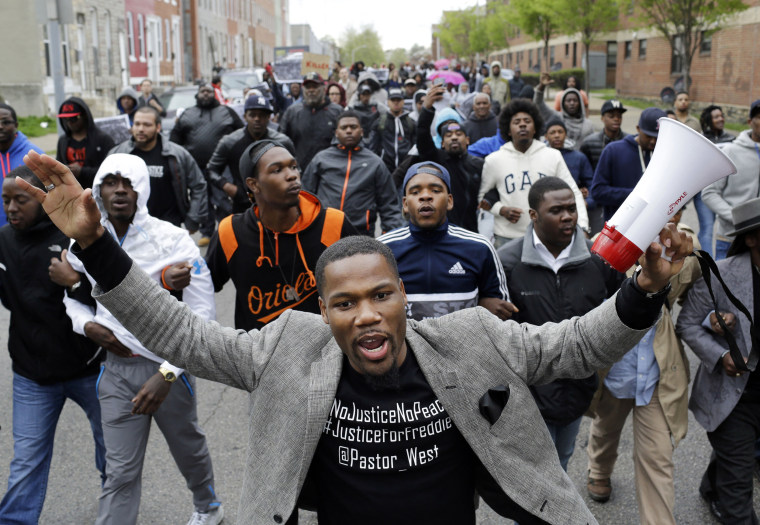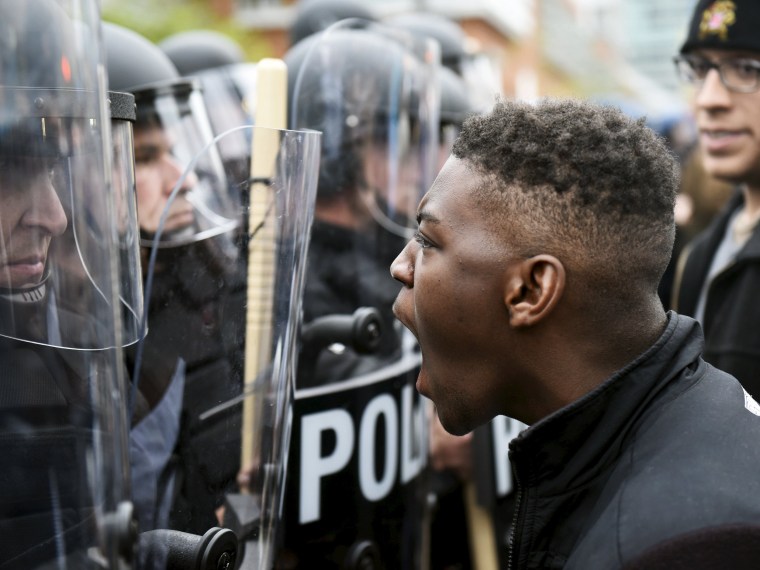Those who came to mourn Freddie Gray were clad in black and filed in somberly as gospel music played.
These were the family members, friends, and neighbors from his west Baltimore neighborhood who sobbed as they walked past the packed rows of pews at New Shiloh Baptist Church and paid their respects to the solitary figure in the pale casket on Monday. The women, men and children jammed into the second floor balcony, prompting the church to open an overflow room with a live feed of the funeral.
For these people, Gray, the 25-year-old black man who died of apparent spinal injuries a week after an arrest by Baltimore police officers, was more than a symbol of the tensions between black communities and law enforcement. For them, Gray was the one who, as long-time friend David Reid recently put it, liked to laugh and play, dance and sing.
Rep. Elijah Cummings, D-Md., spoke of Gray as an invisible man, a black man who lived an ordinarily life before the violent nature of his death opened anew a national conversation on race.
“A little boy was born 25 years ago. You brought him home. You played with him, You watched him grow. And as I thought about the cameras, I wondered if anybody recognized him when he was alive,” Cummings said. “ ‘Did you see him?’ “
Gray was “a junior usher.”
“Did you see him?”
“Loved church… played football.”
“ ‘Did you see him?’ "
Others see in Gray a symbol of the palpable grief and rage of a black community that has come to learn an unwritten code of treading very warily around law enforcement and has come to expect little justice for those who die in police custody. Gray is the latest in a series of deaths of African American men in encounters with police officers.
“For many people this is the kind of stuff people thought was the product of a bygone era. Turns out it wasn’t,” said Andra Gillespie, an associate professor of political science at Emory University in Atlanta. “There’ve been few arenas to talk about these entrenched inequalities such as how to act around police and that it’s not a respect situation but a life or death situation.”
On Monday, Gray’s funeral was that arena.
Civil Rights leader Rev. Jesse Jackson, at a press conference just before the funeral called to “end the epidemic of killing of black men across the country.” During the funeral, Jackson spoke to the economic and educational inequalities that add to frustrations expressed in minority communities.
Civil Rights leader and MSNBC television personality, Rev. Al Sharpton, said in a statement that he was planning to schedule a two-day march from Baltimore to Washington D.C. in May to highlight the death of Gray. He also said he wants to draw attention to similar incidents across the country— including the police shooting of Michael Brown in Ferguson, Missouri, last August.
The march will also highlight Eric Garner, who died last July after being placed in a chokehold by New York police officers and Walter Scott, a black man shot to death by a white police officer earlier this month in South Carolina.
"It's unfortunate, but I feel a connection,” Erica Garner, the daughter of Eric Garner, said at a press conference before the Gray funeral. “What's going on in Baltimore is going on around the country."

On Saturday, more than 1,000 protesters marched to Baltimore City Hall and staged a "die-in" along the way. The group stopped traffic, but remained largely calm.
However, after hours of peaceful protests, a small splinter group broke off and threw objects at officers and smashed windows near Camden Yards where the Baltimore Orioles were playing the Boston Red Sox, police said. The group then made their way to a Baltimore mall where more windows were smashed.
A sign at the baseball stadium briefly told fans to remain inside the ballpark "due to an ongoing safety issue." A group of juveniles also looted a 7-Eleven, police said.
Twelve people were arrested and five officers suffered minor injuries during the protests, according to NBC affiliate WBAL.

But Monday was Gray’s “homegoing”, a time to celebrate his life and mourn his passing.
It was also a call to action against a "corrosion of justice," said Bill Murphy, a Gray family attorney.
Most of the mourners did not gather to grieve over Freddie, “We know lots of Freddies…too many Freddies,” Murphy said.
Nor was the gathering there to “grieve for Baltimore, although we do grieve for the nation,” he said.
The “eyes of country are all on us because they want to see if we have stuff,” Murphy said. They “want to know if leadership is up to task, if we act as one people, or divide by superficiality of race.”
IN-DEPTH
Freddie Gray: At Least 1,000 in Baltimore Protest Death in Police Custody
- Lawyer Says Freddie Gray, Man Fatally Injured in Custody of Baltimore Police, Lacked Seat Belt
- Freddie Gray's Death Prompts Protests, Federal Investigation
- Six Cops Suspended in Death of Baltimore Man, Deny Using Force
— Elisha Fieldstadt, Phil Helsel and Katie Wall
